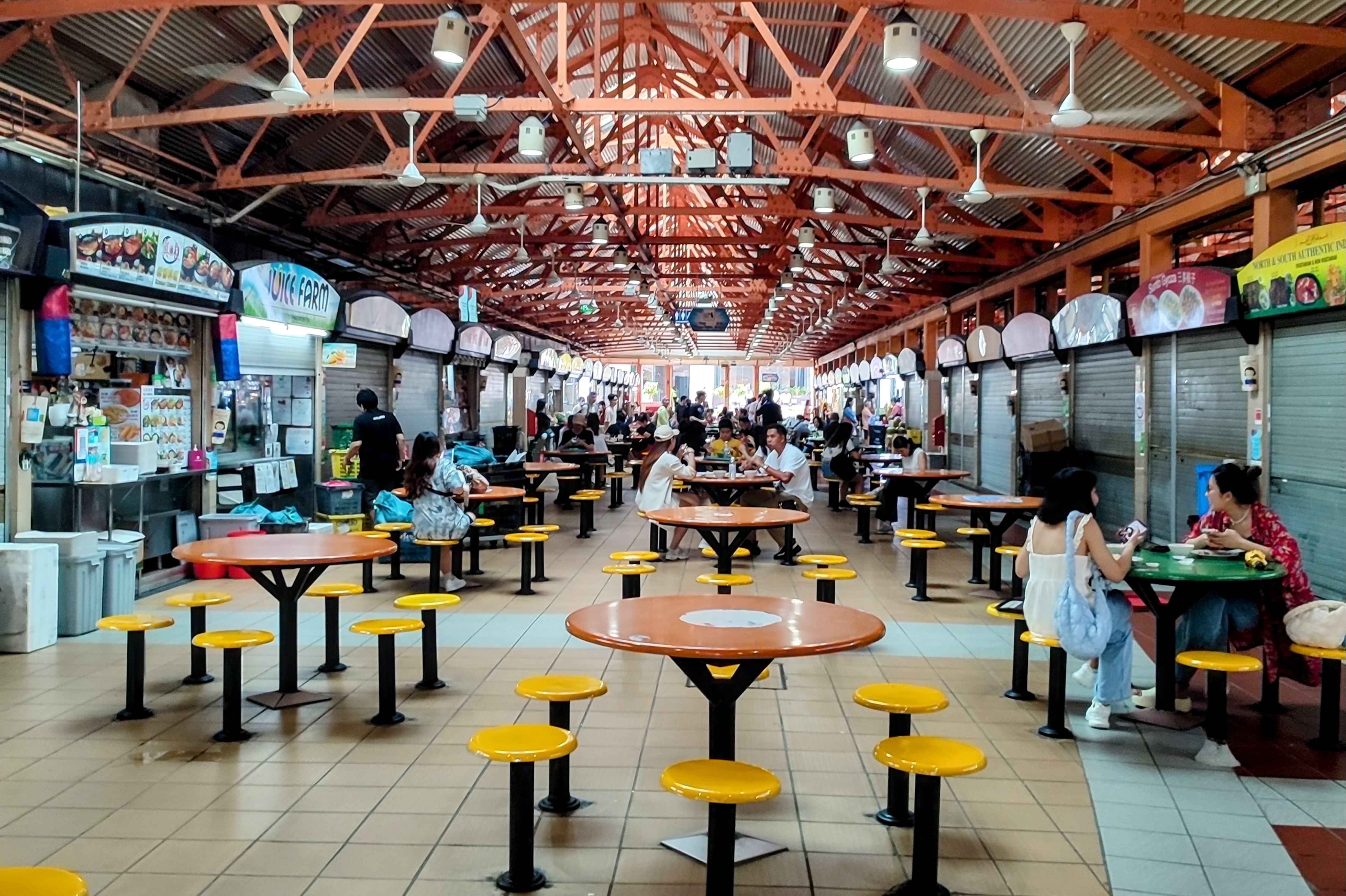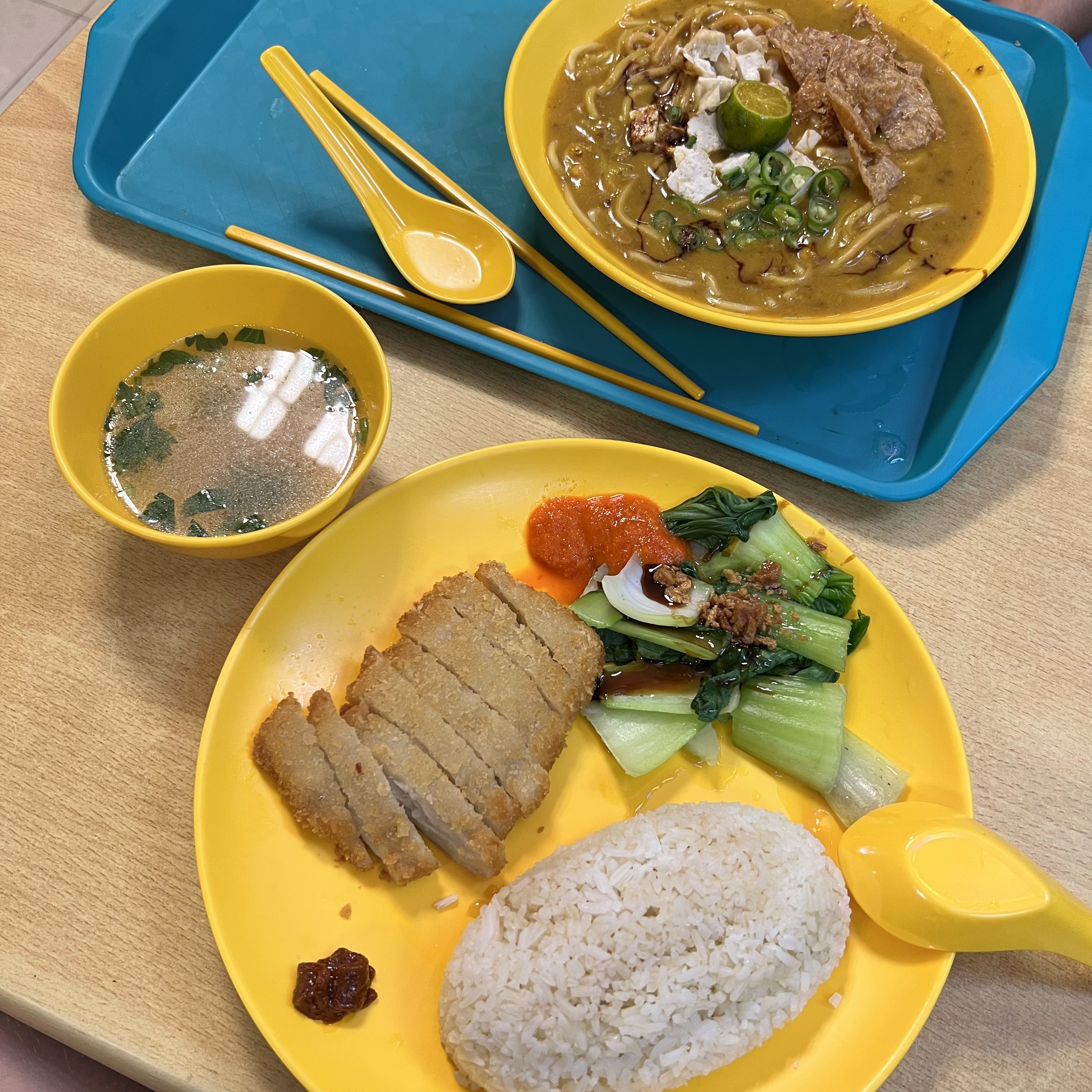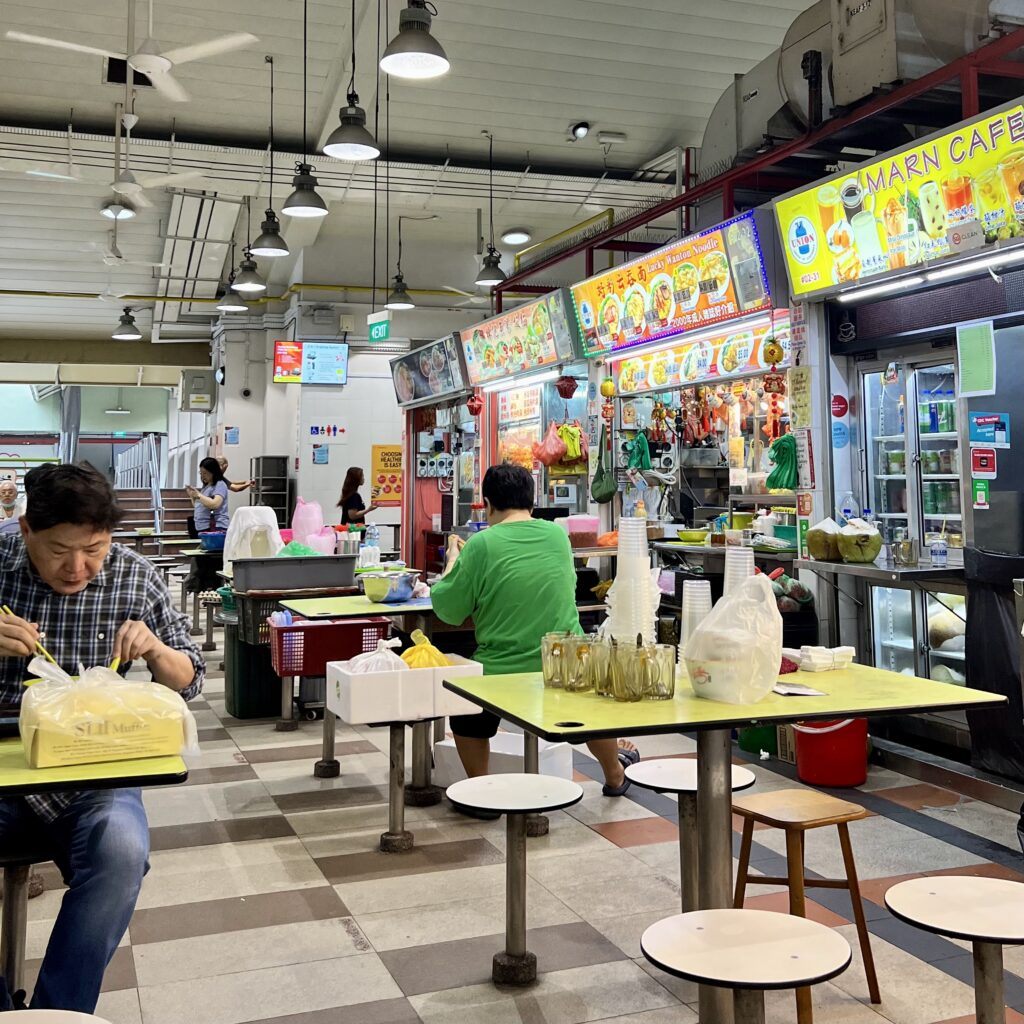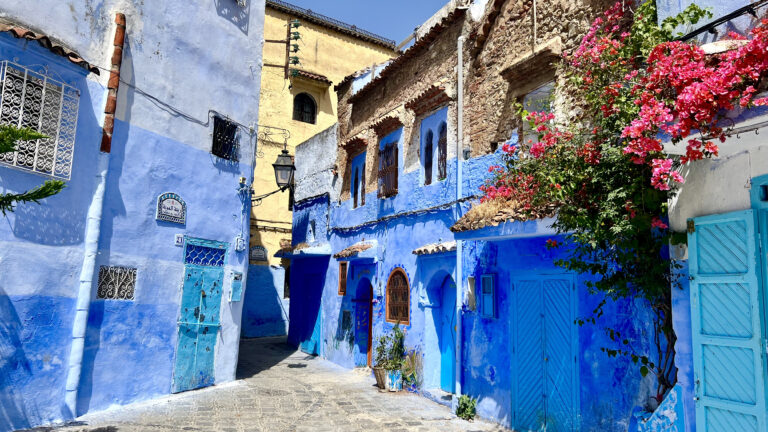The Ultimate Guide to Singapore’s Hawker Centres

Singapore is a food lover’s paradise, and no visit to this vibrant city-state is complete without experiencing the local cuisine at a hawker centre. Hawker centres are a unique feature of Singapore’s identity, and they offer a wide range of delicious dishes that are sure to tantalise your taste buds, and at low costs that welcomingly contrast the country’s expensive stereotype. Considering that hawkers are so cheap, they make their profits by selling a massive amount everyday; which luckily for us, means that they have really perfected their delicious dishes.
In this guide, we will take you on a culinary journey through Singapore’s hawker centres, exploring their history, culinary delights, etiquette, and of course our best recommendations. We will also provide tips on how to navigate these glorious food markets and support local hawker businesses. Whether you are a first-time visitor or a seasoned foodie, this guide has everything you need to know to make the most of your hawker centre experience in Singapore.
Key Takeaways
- Hawker centres are an integral part of Singapore’s food culture, offering a wide range of affordable and delicious dishes.
- Understanding the history and etiquette of hawker centres is important to fully appreciate the experience.
- Navigating hawker centres can be overwhelming, but with our tips, you can make the most of your visit and support local hawker businesses, whilst enjoying some of the best food that Singapore has to offer.
History of Hawker Centres
Hawker centres are an iconic part of Singapore’s food culture. They are essentially large food court complexes that house multiple food stalls serving a variety of local dishes, showcasing a vibrant melange of Chinese, Malay, Indian, Eurasian & Peranakan origins. Each stall only has a handful of items on the menu, meaning that over the years, and sometimes generations, they have really perfected the delicious dishes that they offer. Hawker centres are a ubiquitous sight in Singapore, with both locals and tourists flocking to these culinary hubs to enjoy the exciting and affordable food.
Evolution of Street Food to Hawker Centres
Singapore’s hawker centres have a rich history that dates back to the 1800s, when street food vendors roamed the streets selling food to the locals. These street vendors were known as ‘hawkers’, and they would carry their food on shoulder poles, walking from one location to another.
As Singapore grew and developed, street food became a more organised affair. Hawkers started congregating in specific areas, and makeshift stalls were set up to serve food to the public. Due to hygiene concerns in the 1960s, the Singaporean government decided to create designated centres, which eventually evolved into the hawker centres that have now become a permanent fixture in Singapore’s food scene and a crucial part of local everyday life.
The Singapore government recognised the importance of hawker centres in the country’s food culture and took steps to preserve and promote this unique aspect of Singaporean cuisine. In 1971, the government launched the Hawker Centre Improvement Programme (HCIP) to upgrade the facilities and infrastructure of existing hawker centres. The HCIP was very successful, which then led to the construction of many new hawker centres across the country. Today, there are over 100 hawker centres in Singapore, and they are managed by the National Environment Agency (NEA). The NEA ensures that the hawker centres are clean, hygienic, and safe for both the hawkers and the public.
In conclusion, Singapore’s hawker centres have a rich history that spans over a century. They are an integral part of Singapore’s food culture, and they offer a unique culinary experience that is both affordable and delicious. The government’s efforts to preserve and promote hawker culture have ensured that this aspect of Singaporean cuisine remains vibrant and thriving, all whilst preventing you from getting any dodgy tummies.
Understanding Hawker Centres
These bustling food markets are where locals and tourists alike come to sample some of the best and most affordable food in the city. In this section, we will provide an overview of the layout and design of hawker centres, as well as the common facilities you can expect to find.
Layout & Design
Hawker centres are typically large, open-air food courts with varying stalls. The layout of hawker centres can vary depending on the location and size of the market. Some hawker centres are housed in purpose-built buildings, while others are located in open-air spaces or under covered walkways. Regardless of the layout, hawker centres are designed to be easy to navigate, with clear signage and plenty of seating available.
Some larger centres are divided into different sections, however that doesn’t mean that the types of cuisine are grouped together. Each stall will sell something completely different and unique to the next. You may find a Chinese noodle stall next to an Indian breakfast stall next to Malay dessert stall, so it’s a good idea to have a little walk around to scout out what you may fancy.
Common Facilities
In addition to the food stalls, hawker centres also some common facilities that are designed to make your dining experience as comfortable as possible. These facilities can include:
- Seating: Most hawker centres have plenty of seating available, either in the form of tables and chairs or benches. Most hawker centres will have communal seating areas, where you can sit and enjoy your food alongside other diners.
- Restrooms: Many hawker centres have restrooms available for public use. These restrooms are typically clean and well-maintained, and can be found in a central location within the market.
- Waste disposal: To keep the market clean and tidy, hawker centres have a range of waste disposal facilities available. These can include bins for food waste, recycling bins, and general waste bins.


Hawker Centre Etiquette
Singapore’s hawker centres are a vibrant hub of local culture and cuisine. To fully immerse yourself in this experience, it’s essential to understand the local etiquette. Here are some tips to help you navigate the bustling food markets like a pro.
Queueing & Choping
At busy hawker centres, it is common to see people queuing up for their favourite stalls. If you see a long queue, it is a good sign that the food is worth waiting for. However, be sure to join the queue at the end and wait your turn. Cutting in line is considered rude and may cause tension with other customers.
Another common practice at hawker centres is “choping” a table. This involves reserving a table by placing a personal item on it, such as a packet of tissues or an umbrella. If you see a table with items on it, it means that it has already been reserved. Do not remove the items and take the table unless you want to risk offending the person who reserved it.
Table Sharing
In Singapore, it is common for strangers to share tables at hawker centres, especially during peak hours when seating is limited. If you see an empty seat at a table, it is acceptable to ask if you can sit there. Most locals are friendly and will be happy to share their table with you. When sharing a table, remember to be considerate of your fellow diners by minimising noise and mess.
Clearing Your Table
Helping to maintain the cleanliness of the hawker centre is crucial. After finishing your meal, return trays, plates, and cutlery to the designated area. Dispose of rubbish properly in the bins provided. A quick wipe of your table area is also appreciated. By following these simple steps, you contribute to a pleasant dining experience for everyone.
Hawker centres are a shared space. Respecting local customs and being mindful of others will enhance your enjoyment of this iconic Singaporean experience.
Navigating Hawker Centres
When it comes to navigating Hawker Centres in Singapore, there are a few things to keep in mind. Here are some tips to help you make the most of your experience:
Payment Methods
Most hawker centres in Singapore accept cash only, so be sure to have some Singaporean dollars on hand. Some larger centres may have a few stalls that accept credit cards, but it’s best to assume that cash is king. Prices are usually displayed prominently, so you can easily see how much each dish costs.
Finding a Stall
Hawker Centres can be quite large, so it’s important to know how to find the stalls you want to try. You could obviously play it safe and just pick from our list of our honourable muncheons (Alec insisted, sorry…). Alternatively, one of the best ways to do this is to look for the longest queues. If a stall has a long line of people waiting to order, it’s usually a good sign that the food is tasty and worth trying, and not that the chef is slow!! Another option is to ask locals for recommendations. Singaporeans are extremely passionate about their food, and they’re usually more than happy to share their favourite stalls with visitors.
Once you’ve found a stall you want to try, be prepared to wait a short while for your food. Hawker Centre food is cooked to order so it can take a few minutes for your dish to be ready, but this does mean that the food is fresh and delicious, so the wait will be worth it!
Overall, navigating Hawker Centres in Singapore is a fun and exciting experience. By following these tips, you’ll be able to find the best stalls and enjoy some of the tastiest food the city has to offer.


Culinary Delights
At Singapore’s hawker centres, you are spoilt for choice with a massive range of delicious dishes from various cuisines. Here are some of the must-try dishes and diverse cuisine types that you should not miss.
Diverse Cuisine Types
Singapore’s hawker centres offer a diverse range of cuisine types, from Chinese and Malay to Indian and Western. Here are some of the different cuisine types that you can find at the hawker centres:
- Chinese Cuisine: Chinese cuisine is the most common cuisine type found at the hawker centres, and it includes dishes such as Hokkien Mee, Wanton Mee, and Dim Sum.
- Malay Cuisine: Malay cuisine is another popular cuisine type found at the hawker centres, and it includes dishes such as Nasi Lemak, Mee Siam, and Satay.
- Indian Cuisine: Indian cuisine is also available at the hawker centres, and it includes dishes such as Roti Prata, Biriyani, and Curry Puffs.
- Western Cuisine: For those who prefer Western cuisine, there are also plenty of options available, however these tend to be at the more touristic hawker centres. These centres will be found closer the the Central Area of Singapore, the CBD and the marina, such as the Lau Pa Sat and Makansutra Gluttons Bay centres.
Must Try Dishes
- Hainanese Chicken Rice: This dish is a staple in Singaporean cuisine, and it is a must-try for anyone visiting the hawker centres. The poached chicken is served with fragrant rice cooked in chicken broth and a side of chilli sauce and ginger sauce.
- Nasi Lemak: A popular Malaysian dish featuring fragrant rice cooked in coconut milk and pandan leaf. This aromatic foundation is accompanied by a medley of flavours, usually including crispy anchovies, spicy sambal, roasted peanuts, cucumber, and a hard-boiled egg. Every Nasi Lemak stall will have slightly different toppings, such as a chicken leg or a fried fish, so try a few to find your favourite!
- Chilli Crab: This culinary sensation is Singapore’s pride and joy, but it doesn’t come cheap (the only dish on this list that isn’t budget). Succulent mud crab bathed in a rich, spicy tomato-based sauce. Traditionally served with fluffy steamed buns for soaking up the delectable gravy, chilli crab is a must-try for any food lover visiting Singapore.
- Hokkien Mee: A harmonious blend of egg and rice noodles, slow-cooked in a rich prawn broth until imbued with its essence. The noodles are then stir-fried with a tantalising medley of eggs, pork, prawns, and squid, creating a symphony of textures and flavours.
- Satay: This is a popular street food in Singapore, and it is made with marinated meat skewered on bamboo sticks and grilled over charcoal. The dish is served with a spicy peanut sauce and cucumber and onion slices.
- Laksa: A spicy, aromatic broth made with coconut milk and a blend of herbs and spices. The rich broth is typically served with rice noodles and a variety of toppings, including succulent shrimp, savoury fish cakes, tofu puffs, and cockles.
- Char Kway Teow: This stir-fried noodle dish is a favourite among locals and visitors alike. The dish is made with flat rice noodles, eggs, bean sprouts, Chinese sausage, and prawns, and it is cooked over high heat to give it a smoky flavour.
- Roti Prata: A beloved street food staple, and an absolute favourite of ours, roti prata is a flaky flatbread that’s crispy on the outside and soft on the inside. Traditionally served with a flavourful lentil dal curry, this dish has evolved to include an array of sweet and savoury fillings, such as cheese, onions, and other creative combinations, although we prefer the original the best!
Overall, Singapore’s hawker centres offer a wide range of culinary delights that are sure to satisfy any palate. Whether you are a local or a visitor, there is always something new and exciting to try at the hawker centres.


Iconic Hawker Centres
There are currently 119 hawker centres in Singapore, with a plan to build several more by 2027! Although you will (and you definitely will), find fantastic food at every one of these centres, here is an extensive list of some of the very best things to order at some of the more iconic hawker centres in Singapore.
You. Are. Welcome.
Amoy Street Food Centre
A bustling hawker haven nestled in the heart of Singapore’s CBD. Mainly filled with businesspeople who work nearby, but also locals and tourists alike, this is a busy and exciting atmosphere offering a delicious and authentic dining experience.
Hoo Kee Bak Chang Michelin Bib Gourmand – Rice Dumplings
J2 Crispy Curry Puff Michelin Bib Gourmand – Curry Puff v
Fried Kway Teow – Char Kway Teow
Chinatown Complex
The heartbeat of Chinatown, the Chinatown Complex, is the largest hawker centre in Singapore, with over 260 food stalls and 3 floors all under one roof. This hawker centre is an absolute must visit for anyone looking to experience the true flavours of Singaporean cuisine. The basement floor is a wet market and the ground floor is full of little market shops, which are both worth a visit. The top floor of the complex is the where the food is at. A huge food court, colour coded into 4 different sections to help you not get lost, offering a wide variety of tasty options.
Lian He Ben Ji Claypot Rice – Mixed Rice
Chef Leung’s Authentic Hand Milled Rice Noodle Rolls – Chee Cheong Fun
Jin Ji Teochew Braised Duck & Kway Chap – Duck Rice Bento
Ann Chin Popiah – Popiah
Xiu Ji Ikan Bilis – Yong Tau Fu
Not Your Grandpa’s Grill – Fish & Chips
Monan – Pork Soup
Fortune Centre
A vegetarian and vegan haven! This unassuming mall on Middle Road is a plant-packed paradise that doesn’t skimp on taste. This unassuming mall is packed with delicious vegetarian and vegan options that will surprise and delight even the most ardent meat-lover. From classic Singaporean dishes reimagined without meat to innovative plant-based creations, Fortune Centre is a must-visit for anyone seeking a flavourful and compassionate dining experience.
Bodhi Deli – Chicken Cutlet ![]() , Thai Basil Rice
, Thai Basil Rice ![]() & Mini Wok Noodles
& Mini Wok Noodles ![]()
Herbivore – Katsu Curry ![]()
Living Wholesome Vegetarian – Thunder Tea Rice ![]()
Su Shi Piao Xiang – Kwap Chap ![]() & Lor Mee
& Lor Mee ![]()
Pine Tree Cafe – Nasi Lemak ![]() & Laksa
& Laksa ![]()
Hong Lim Market and Food Centre
Conveniently located beside Chinatown Point, Hong Lim Food Centre is a vibrant hub of Singaporean cuisine. This bustling hawker centre boasts a diverse range of hawker stalls which are very popular with the locals, especially during lunchtime.
Ji Ji Noodle House – Signature Char Siew Wanton Noodle
Famous Sungei Road Trishaw Laksa ![]() – Laksa & Mee Siam
– Laksa & Mee Siam
Granny’s Pancake – Ban Chang Kueh ![]()
Eddy’s – Duck Confit & Mala Shrimp Spaghetti
Lau Pa Sat Hawker Centre
This historic landmark, with its iconic octagonal structure, has been a culinary hub for decades. From its humble beginnings as a wet market to its current status as a world-renowned food destination, Lau Pa Sat continues to enchant visitors with its rich history and diverse food offerings. Definitely the most touristic hawker centre of them all, which bodes well if you happen to be in the mood for some different cuisine and a lively atmosphere. Amongst the traditional options of Malay, Indian and Chinese stalls, there is a wide range of Western, Thai, Mexican, Japanese, Filipino and Korean options to explore.
Nasi Lemak Ayam Taliwang ![]() – Nasi Lemak & Chicken Fillet Curry Rice
– Nasi Lemak & Chicken Fillet Curry Rice
Maya’s Veggie Delight – Deluxe Veg Set ![]() & Khadai Paneer
& Khadai Paneer ![]()
Seng Kee Local Delights – Laksa
Butter & Cream Bakery – Salted Egg Tart ![]() & Hokkaido Koibito Doffin
& Hokkaido Koibito Doffin ![]()
Kallang Airport Wanton Noodle – Signature Wanton Noodle
The Warung Bali – Ayam Betutu Original Set
Su Xiang – Pickled Vegetable & Mushroom Mian Xian ![]()
Rokus a.g.b – Gojuchang Burger
Satay Street
The best place to try some of Singapore’s tastiest satay skewers is on the infamous Satay Street (of course). Located just outside the Lau Pa Sat centre, between 7pm-3am on weekdays, and 3pm-3am on weekends, Boon Tat Street closes and becomes Satay Street. We recommend stalls 7 & 8, but bear in mind there will be a wait of around 20-30 minutes.
Maxwell Road Hawker Centre
A favourite of ours, the Maxwell Road Hawker Centre is one of the oldest and most iconic hawker centres in Singapore. Not far from the Chinatown complex, this centre is full of some absolute gems, and what Alec thinks is the best Chicken Rice this is out there.
Tian Tian Hainanese Chicken Rice ![]() – Hainanese Chicken Rice (Steamed)
– Hainanese Chicken Rice (Steamed)
Zhen Zhen Porridge – Cantonese Style Congee
Mr Appam – Pandan Brown Sugar Coconut Appam ![]()
The 1950s Coffee – Kaya Toast ![]()
Old Airport Road Food Centre
The Old Airport Road Food Centre is a culinary gem worth seeking out. Located slightly outside the city centre in the Geylang district, this hawker centre offers a truly authentic Singaporean dining experience.
Nam Sing Hokkien Mee – Hokkien Mee
Xin Mei Xiang – Signature Lor Mee
Famous Old Airport Fried Oyster – Oyster Omelette
SALT – Signature Chicken Cutlet
Tiong Bahru Market and Food Centre
More than just a marketplace, Tiong Bahru Market is a cornerstone of its community. This trendy and spacious, two-story building houses over 200 stalls, serving as a bustling wet market below and a vibrant hawker centre above. A melting pot of flavours and fresh produce, it’s a beloved local spot that has stood the test of time.
Tiong Bahru Hainanese Boneless Chicken Rice ![]() – Chicken Rice (Roasted)
– Chicken Rice (Roasted)
178 Lor Mee – Lor Mee
Ru Yi Vegetarian Food – Bee Hoon ![]()
Min Nan Prawn Noodles – Prawn Noodles (Dry Soup)
Jian Bo Shui Kueh ![]() – Chwee Kueh
– Chwee Kueh
Final Thoughts
We hope that this helps you out to make a start with sampling some of the most amazing food that Singapore (and probably the world!) has the offer. Whether you’re an avid foodie or just looking to experience the local culture, these hawker centres are an absolute must for anyone travelling to Singapore.






